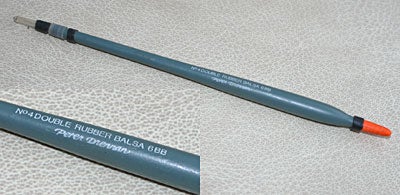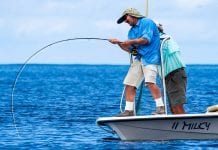| FIRST CLASS FISHING | |
Dave will cover a specific topic at a time in this bi-weekly column. The first section will be really basic with subsequent ones building on the skills covered previously. His aim is to explain things as simply and concisely as possible and will assume that the reader knows absolutely nothing about the subject. |
Part Eight – Avons and Balsas In part seven of Float Fishing I introduced you to fishing with the stick float. In this part I will be looking at the stick floats big brothers, the Avon and the Balsa. Avon and Balsa floats are designed to take on water that a stick float isn’t capable of dealing with. They can fish fast, deep and turbulent water and, due to their larger shotting capacity, can also be adequately controlled much further out than a stick float can be fished. Many anglers shy away from fishing fast water, especially with a float, but in summer months when rivers are low and oxygen levels are depleted, the faster water is often where the fish will be. Fast and turbulent water has a much higher oxygen content than still and sluggish areas of the river and hence the fish will congregate here to take advantage. So running a float fished bait down with the current through the fast water can often produce a big bag of fish. The Avon and Balsa floats are the tools you need for this job. What is an Avon float? Avon floats are made in much the same way as sticks with the buoyant body and denser stem, but they have a much bigger, bulbous body with a slender stem and have a longer, slimmer tip that can be easily seen at distance or in choppy water. They take a lot more shot than a standard stick and are usually shotted with a bulk down near the hook to get a bait down to the bottom quickly. They were designed originally to fish the fast gravel run swims of the Hampshire Avon. There is also a special design of Avon float that was developed for use on the Bristol Avon which is known as the Topper Avon. It was created by local matchman Topper Haskins who used the float to win many a match on the Bristol Avon. It is made from balsa and crow quill, with a body that is narrower and longer than a standard Avon and with along slender tip to give the float maximum sensitivity despite its shotting capacity. It is designed to fish steady water that is more than five feet deep. What is a Balsa Float Balsas are made of a single, very buoyant material, usually balsa wood surprisingly, though you can get polystyrene and hollow plastic versions these days. They have fat, very buoyant tops capable of taking a lot of shot with versions requiring multiple SSG’s. Balsa floats ride very turbulent water well and are ideal where you encounter fast, swirling water, like a weir pool for instance. They are also ideal for fishing large, soft baits like bread or luncheon meat as the weight of the float is easier to cast a reasonable distance without the soft bait flying off the hook. Lighter stick floats don’t have the buoyancy to support a heavy bait like meat and require more effort to cast out, which makes keeping a soft bait on the hook difficult. A Balsa solves these problems. One particular version of the Balsa, being very fat and stubby, is often referred to as a ‘chubber’ float being synonymous with fishing soft baits like bread for chub in fast water. Fishing an Avon Float You would choose an Avon float in swims where a stick will struggle due to it’s lightness, either because of the force and depth of the current, or maybe because you want to fish a bit further out and therefore need additional weight to maintain control or possibly because you have a long swim where you want to trot maybe forty yards or more downstream. Avons are generally shotted with a bulk down the line, somewhere between 10 and 30 inches from the hook. Use a string of BB’s bunched together rather than larger AAA’s or SSG’s as these are more streamlined, then have one or two dropper shot below this bulk. You don’t need very small droppers, with a no.6 being about the smallest required. Due to the fact that the water is likely to be travelling reasonably fast, fish have little time to make up their minds to take a bait and usually do so very positively, so subtle shotting is not usually a requirement. The shot is there to get the bait near the bottom quickly and keep it there. Tackling the Topper On the Bristol Avon, Topper Haskins wanted to fish the deep water under the far bank of some the match stretches. The standard stick float wasn’t man enough for the job as it required an overhead cast to reach the swim which was handicapped by the rivers high banks and often resulted in tangled rigs. The standard stick also didn’t have enough weight down the line to get the bait down quickly enough to his target fish. To solve these problems he developed this unique float, which carried a good bulk of shot down the line to get the bait down quickly, could be cast a fair distance with an underarm cast, but with its long thin tip still gave a high degree of sensitivity. Today the Topper finds similar uses on many deep but pacy swims on many rivers for anglers targeting roach and chub. Ideally suited to swims deeper than 5 feet and with an even flow, the Topper gets the bait down to the quality fish feeding near the river bed. Again, all the bulk can be set about 30 inches or less from the hook with a dropper pattern of no.4’s below this. Trotting the Balsa Use the balsa to fish really turbulent water, either deep, swirling water like that encountered in weir pools or over faster, shallow water where a rocky or uneven bottom causes the water to chop and change direction. The high buoyancy of this float prevents it from being dragged under as a lighter float would be. The Balsa is set up in much the same way as the Avon with a bulk of shot placed below the halfway point between the float and hook. If the water is just fast and the bottom is pretty even, like a gravel run, you can get away with having all the bulk set just 10 – 12 inches or so from the hook, with no need for droppers. However, if the bottom is rocky or uneven you will need to closely space a few droppers below the bulk to combat the turbulence caused by the rocks and undulations on the river bed. Spread no.4 dropper shot around 2 inches apart to within 6 inches of the hook. This set up is ideal for targeting fast water chub and barbel. The first eight parts of First Class Fishing has introduced you to the principles of float fishing. Next time First Class Fishing will see the start of a new topic, legering, with part 1 covering the initial basics and kit required. See you then. |














